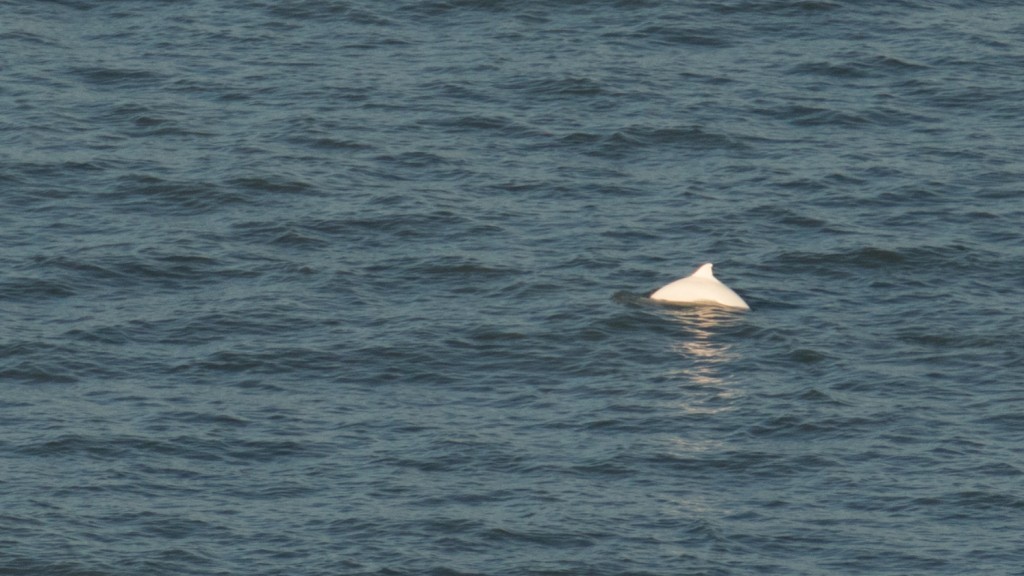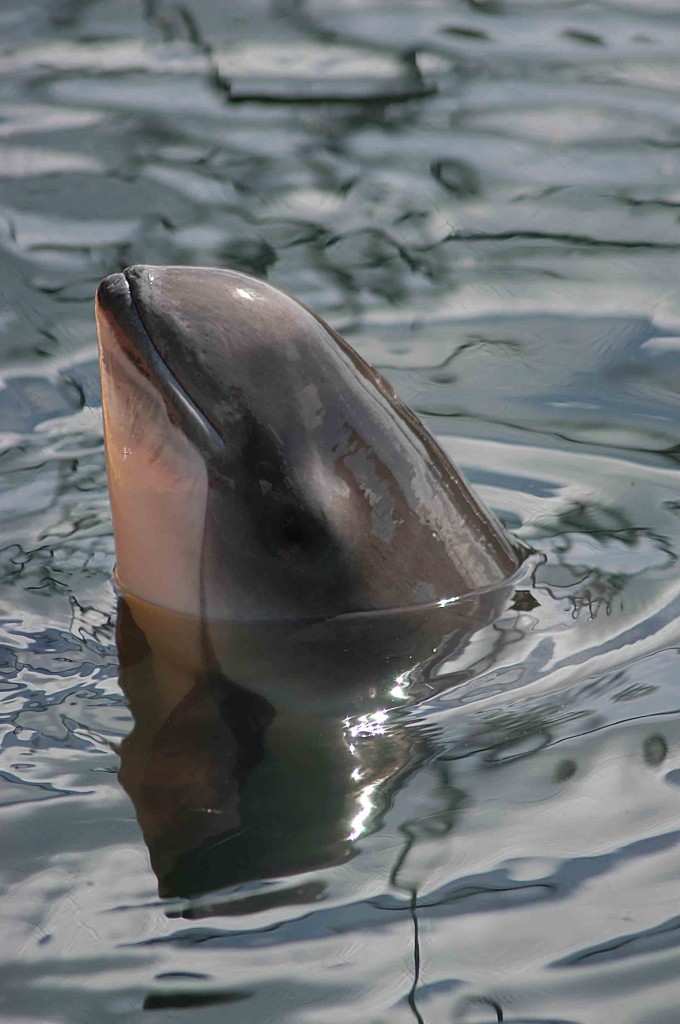Sea Watch Foundation are no strangers to reports of weird and wonderful sightings around the coasts of the UK. In fact, it is part of their mission to encourage people to report what they see. Logging on to her emails this morning, Sightings Officer, Kathy James was surprised to see a picture of what seems to be only the sixth documented harbour porpoise with all white colouration ever seen in UK waters!
 The white harbour porpoise. Photograph by Henry Kirkwood/ Sea Watch Foundation.
The white harbour porpoise. Photograph by Henry Kirkwood/ Sea Watch Foundation.
Harbour porpoises are usually a uniform brown to grey colour with lighter underparts, and many people all over the UK will have been lucky enough to glimpse them as they make a brief appearance at the surface to breathe.
“Henry’s photograph shows the typical view that an observer usually has of a harbour porpoise, with a broad-based, triangular dorsal fin showing in the centre of its back. However, the big difference is that they are not usually white!” says Kathy.
 The more typical colour of a harbour porpoise. Photograph by Mick Baines/ Sea Watch Foundation.
The more typical colour of a harbour porpoise. Photograph by Mick Baines/ Sea Watch Foundation.
Henry was in awe of his sighting and his father, Rupert, who got in touch with Sea Watch Foundation to report the incident, said his eyes were on stalks when he saw the photograph!
The animal was sighted off Morwenstow in north Cornwall, close to the border with North Devon. People are urged to keep an eye out for this distinctive character and to inform Sea Watch Foundation if they spot anything at: www.seawatchfoundation.org.uk/sightingsform.
“On Monday 28th November I spent a very enjoyable day photographing the wildlife around Morwenstow, North Cornwall, focusing primarily on the resident peregrine falcons. I also had an uninterrupted view of the sea stretching from Travoise Head, 30 miles away to the south, to Lundy Island 15 miles to the North. Weather conditions were perfect for spotting cetaceans with a light offshore wind and small swell. In the first 4 hours from my viewpoint sat on top of the towering 200 feet cliffs, I had seen several seals and a couple of conventionally coloured harbour porpoises.
Whilst scanning out to sea, my attention was drawn to a small white glint. Initially I thought that this might be the fin of a very pale Risso’s dolphin, but on closer inspection through binoculars I was amazed to see what looked like a completely white porpoise!
The selection of photos show that the porpoise was completely white, apart maybe from some darker pigment around the blow hole. I had no idea quite how unusual this observation was, until I arrived home and trawled through the internet to learn that there has been only a handful of such sightings reported, and hardly any photographs. I went back the next day to try and get some better images knowing that porpoises tend to be quite sedentary, but with no luck.” Henry recounts.
 Another view of the porpoise, showing some darker colouration around its blowhole.
Photograph by Henry Kirkwood.
Another view of the porpoise, showing some darker colouration around its blowhole.
Photograph by Henry Kirkwood.
Henry and his father Rupert, take part in the research charity’s national sightings scheme by reporting their sightings of whales, dolphins and of course, porpoises. The organisation uses this information to build a picture of the marine life around the UK and have been doing so for more than forty years. Using information from members of the public in this way, Sea Watch are able to report on their status and distribution and to advise on governmental policies for the protection of the species.
To get involved with the sightings scheme, please visit: www.seawatchfoundation.org.uk/become-a-sea-watch-observer.
 It’s not often that one gets to glimpse the whole head of a harbour porpoise.
Photograph by Mick Baines/ Sea Watch Foundation.
It’s not often that one gets to glimpse the whole head of a harbour porpoise.
Photograph by Mick Baines/ Sea Watch Foundation.
Many people might be tempted to refer to the animal as an albino. Albinism is caused by a genetic mutation resulting in the animal being unable to produce melanin, the pigment which gives rise to colour. However, it’s thought that the animal’s appearance is because of a phenomenon called leucism, whereby only some of the cells lose the ability to produce melanin.
Whatever the process, it certainly results in a distinctive looking animal and is only the sixth documented case around the UK.
























